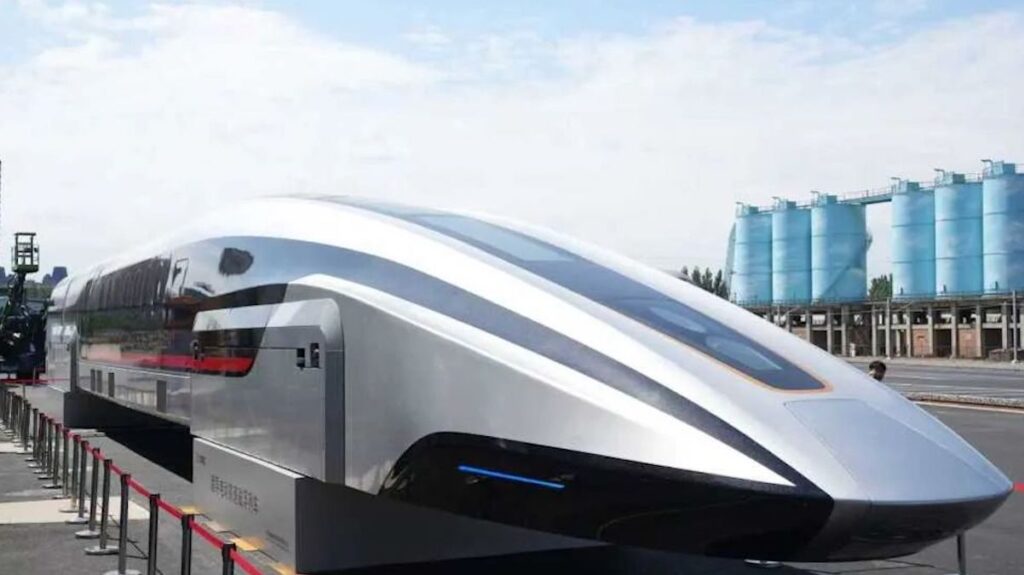China previewed its new magnetic levitation (maglev) train, boasting a maximum speed of 600 kilometers per hour (373 miles per hour), in a recent event after completing the first phase of its engineering design.
If successfully built and operated, this bullet train can catch up with Japan’s fastest maglev train: the L0 Series, which achieved a record speed of 603 km per hour (375 mph) during a test run in April 2015. The L0 Series trains run at a maximum speed of 500 km per hour (311 mph) in commercial service, offering a journey time of 1 hour 7 minutes between Tokyo and Osaka.
China’s new maglev train, developed by China Railway Rolling Stock Corporation (CRRC), was displayed at the 17th Modern Railways exhibition in Beijing from July 8 to 10. China State Railway Group and the International Union of Railways (UIC) also co-hosted the 12th World Congress on High-Speed Rail at the same venue.
The vehicle can travel between Beijing and Shanghai in 2.5 to three hours, compared with the four-hour journey achieved by the current high-speed train.
In China, the Shanghai Maglev is currently the fastest train in commercial operation, reaching 430 km per hour (267 mph) between Shanghai Pudong Airport and Longyang Road station. It used technology developed by Transrapid International, a joint venture between Siemens and Thyssenkrupp in Germany.
“The new superconducting maglev train will be used to supplement the existing network to implement point-to-point transportation,” said Shao Nan, a senior engineer at CRRC Changchun Railway Vehicles. “It can fill the speed gap between high-speed rail and aviation within 2,000 km per hour (1,243 mph).”
She said the vehicle will move on rubber wheels when its speed is below 150 km per hour and will be lifted by magnetic fields when moving faster than that. Footage from the state-owned China Central Television showed an animation about how the rubber wheels are retracted before the train enters a maglev mode.
Shao added that the first phase of the train’s engineering was completed in July last year. She said the company will carry out more route and safety tests and engineering viability assessments for the train before deploying the train for commercial use.
Germany’s technology
CRRC Changchun did not announce any roadmap for the train’s commercial operation. It also did not disclose any information about how the train was designed and built, or whether any foreign partners were involved.
This train likely came from the same project as the CRRC 600, which was developed by CRRC Qingdao Sifang (CRRC Changchun’s sister company) using Transrapid technology under license from the German firm Thyssenkrupp.
Back in 2016, CRRC announced that it would develop a maglev train with a designed top speed of 600 km per hour. In July 2018, CRRC and Thyssenkrupp signed a memorandum of understanding (MOU) on technology cooperation, targeting applications in the fields of smart mobility, magnetic technology, environmental protection, and renewable energy.
In July 2021, Xinhua reported that CRRC Qingdao Sifang, a fully-owned unit of CRRC, “self-developed” the CRRC 600. The company allowed visitors to experience for themselves inside the train’s cabin. In September 2023, it displayed the same train at the 2023 World Manufacturing Convention in Hefei, Anhui province.
An academic paper published by a group of Chinese and German mechanical engineers in March 2023 showed a close partnership between CRRC Qingdao Sifang and Thyssenkrupp.
In February 2024, the European Commission launched an anti-subsidy probe into CRRC Qingdao Sifang over its bid for a €610 million (US$712 million) Bulgarian public procurement contract to provide electric trains, along with maintenance and staff training. The EC stopped the investigation after CRRC Qingdao Sifang withdrew its bid.
Now, the CRRC Changchun has become the project manager of CRRC’s new maglev train.
Commercial value
An article published by China Youth Net, a unit of the Communist Youth League of China, said that, from the perspective of commercial value or future applications, high-speed maglev lines are more suitable for use between some large urban clusters with high-end passenger traffic.
It added that, from the energy consumption perspective, the longer the distance the more obvious the comprehensive benefits and advantages.
“If high-speed maglev lines only serve Beijing, Shanghai, and Guangzhou, the passenger flow will be far from enough,” the article said. “Besides, ticket prices for these maglev trains will have to be higher than those of the existing high-speed railways in the future.”
Citing industry experts, the article said it will take a long time before CRRC’s new maglev train can begin commercial operations.
Some analysts have pointed out that weak market demand, rather than maglev technology, is the main obstacle for China to accelerate its high-speed train.
In February this year, a group of Chinese commentators said a report by the National Audit Office (NAO) had found that China’s high-speed railway saw an “about 100 billion yuan of total loss” in the nine months ending December 31, 2024.
A Guancha.cn article also said China’s high-speed railway network was 45,000 kilometers at the end of 2023, but only 2,300 kilometers, or 6% of the total, could make a profit.
Read: China’s fast-growing high-speed railway network faces reality

